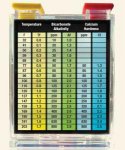There are a lot of misunderstandings about the saturation index in the pool industry and John A. Wojtowicz tried to clear this up and I wrote about some of this in
this thread a while back. I disagree that high TDS is overstated -- if anything, it has been understated. Temperature dependence is also important and is not always done correctly.
The article you refer to has a few things that aren't quite right. Though it is true that Langleier himself never wanted the index named after him, it isn't exactly a calcium saturation index. What is saturated is calcium carbonate; calcium alone does not get saturated so that is misleading. The solid form of calcium carbonate that is specifically saturated is called calcite (as opposed to aragonite or vaterite). So the index could be properly called the Calcite Saturation Index and is what I call it since it is quite specific about this being calcium carbonate and specifically in terms of the solubility of calcite which is the first form of calcium carbonate that would precipitate as scale and it is also what is in limestone (including marble dust often used as an aggregate in pool plaster) and it is the equilibrium constant (solubility product) used in the saturation index.
If, as stated in the article, Professor Langelier's original tables only had a one-tenth change going from 1000 to 10,000 ppm TDS, then that is clearly wrong. The TDS adjustment is a very specific adjustment for ionic strength and its effect on the effective concentration (aka "activity) of ions, a chemical concept that has been known for a very long time and that Langelier should have known as well. This sounds more like a mistake, either in original development of the equations or in some transcription of it either by Langelier or in the pool industry. Also, the temperature dependence has become more precise over time as the thermodynamic quantities for the various equations have been more finely determined (or, somewhat equivalently, equilibrium constants at various temperatures).
Near the bottom of my spreadsheet here you can see the derivation of the CSI and can note that there is absolutely nothing about this derivation that has to do with open vs. closed systems. The outgassing of carbon dioxide is relatively slow so for practical purposes the pool water is a closed system as far as the CSI is concerned. There is absolutely nothing about being open to the air that invalidates chemical equilibrium when the changes from that openness are slow relative to the reaction rates (and circulation rates) of the chemical equations involved in the CSI. Also, the TDS dependence comes from ionic strength while the temperature dependence comes from the thermodynamics (temperature dependence of the equilibrium constants) of the various equations.
As for a qualitative reason as to why water that is higher in TDS (specifically, ionic strength) has a lower saturation index, the primary affected equilibrium equation is that of calcium carbonate solid going to calcium ions and carbonate ions. Essentially, when there are more ions (charged substances) in the water, they somewhat shield each other behaving as if they are lower in concentration. Ions that are doubly charged, such as calcium and carbonate ions, are affected more by a factor of 4 compared to singly charged ions. So because the effective concentration (aka "activity") of calcium and carbonate ions is reduced in saltier water, this means it takes higher concentrations to saturate the water or put another way higher TDS has the saturation index be more negative for the same water parameters.
There are other equations affected by ionic strength including the carbonate buffer system equations for dissolution of carbonic acid. The net effect is that the most important ions that are affected by the ionic strength are calcium and bicarbonate and that the second dissociation (the one from bicarbonate ion to carbonate ion) partly counteracts what I described above for calcium and carbonate. All of these detailed calculations are in my spreadsheet computations as well as in the derivation near the end of the spreadsheet. The spreadsheet closely matches the Taylor watergram for non-salt pools. It is also consistent with what Wojtowicz has done except he used newer equilibrium constants from other sources and I have that as an option in my spreadsheet though it is not the default. Using Wojtowicz numbers, the saturation index would be around 0.12 to 0.14 higher in the most common conditions.
Technically, TDS is total dissolved solids and doesn't necessarily mean charged substances, but in practice in high TDS pools the main component of TDS is sodium chloride (i.e. salt).
It turns out that my first foray into pool water chemistry was initiated by my noticing how the Taylor watergram didn't match the saturation index calculated by the "standard" tables (though there was more than one such standard on the Internet). That's when I created my initial spreadsheet. I had Cyanuric Acid equations, but didn't have chlorine combined with CYA (i.e. the chlorinated isocyanurates) and it was in that search, including conversations with Ben Powell with reference to Wojtowicz, when I eventually found the O'Brien paper that definitively determined the chlorine/CYA relationship.
Richard


